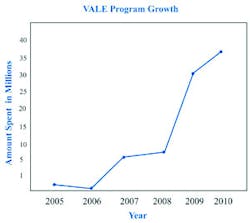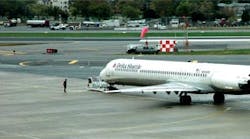The Voluntary Airport Low Emissions (VALE) program has continued to be a viable option for airports looking to acquire environmentally friendly infrastructure and equipment.
Since its inception in 2005, the program has paid out more than $80 million in funding to airports across the country. Several new projects have recently been finalized at several airports for the 2010 fiscal year.
The program
Beginning in 2005, the VALE program was established after the ILEAV pilot program that existed from 2001 to 2005. Funding through VALE is available for commercial service airports in nonattainment areas to help acquire infrastructure and equipment that will reduce overall emissions at that location.
The funding for the VALE program comes from two separate avenues: the Airport Improvement Program and Passenger Facility Charges. The two avenues of funding have offered some options for procuring equipment of different types. In the case of GSE at airports, funding from PFCs can be obtained for all fuels, while AIP funding is restricted to alternative fuels or hybrids, according to Jake Plante of the planning and environmental division at FAA.
“Regardless of the funding program or the fuel type,” Plante explains, “vehicles purchased under VALE must meet low-emission standards based on EPA national standards. We’ve set hard standards in five vehicle categories to make sure we aren’t just funding an incremental improvement in each of those, but netting a long-term benefit, and getting the best technology available.”
Current projects
Several projects have been recently finalized to receive VALE funding in the 2010 fiscal year, which the FAA has expected to total about $37.3 million. The funds will be dispersed to 12 airports for 14 separate projects; among them include Lehigh Valley International Airport in Pennsylvania.
The FAA has approved the dispersal of $2.5 million for three projects: PCA at eight gates; eight electric GSE and rechargers, and six hybrid vehicles. Gerald R. Ford International Airport in Grand Rapids, Mich., has also been approved to receive $1 million dollars for gate power and PCA at five gates.
While there is no limit on how much can be spent through the VALE program in a fiscal year, the amounts have shown overall growth year-over-year. “We have increased VALE allocations over time based on demand for the program,” Plante says. “In 2005 and 2006, when we were just starting and working with our community, we were only spending a couple hundred thousand dollars. In 2007 it jumped to $7 million, in 2008 to $9 million, and in 2009 to $32 million.”
VALE and airline-owned GSE
According to Plante, about 18 percent of VALE funding so far has gone to cleaner GSE at airports; an even smaller percentage has gone to airline-owned GSE. “AIP requires that vehicles and equipment be airport-owned or leased and that they remain at the airport for their useful life,” says Plante. “These requirements can be sticking points when airline-owned GSE are involved.”
The program has required airlines and airports to work together to mutually benefit from the funding opportunity. He points to the project in Philadelphia — the largest airline-owned GSE project supporting 228 units — as a special case where it worked for both airport and airlines.
“At Philadelphia, the FAA funded the rechargers, and the airlines bought the electric GSE and made a commitment to the FAA that those vehicles would stay at Philadelphia for its useful life,” he says.
“The airline commitment was given. That was the difficult part to overcome, but good financial incentives were there.”



